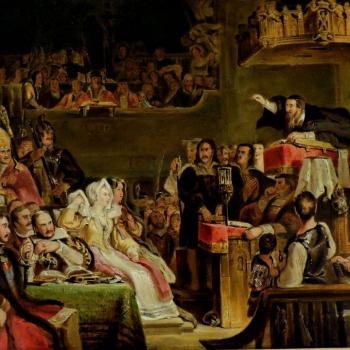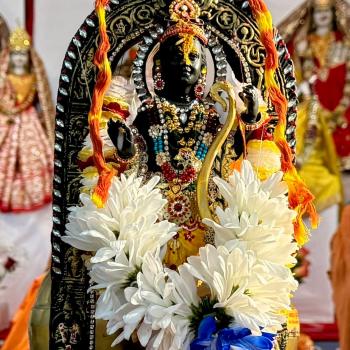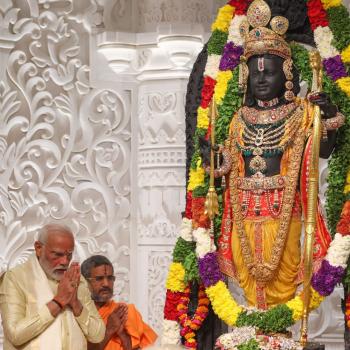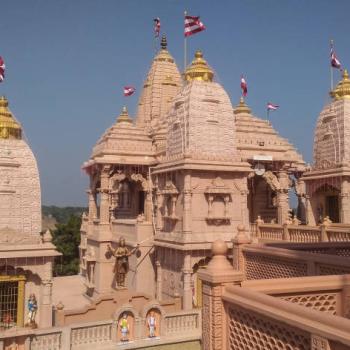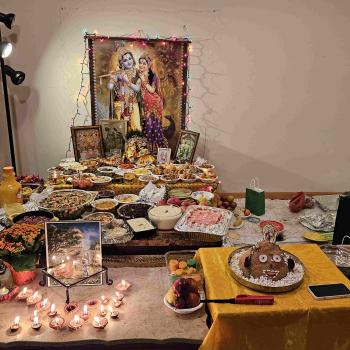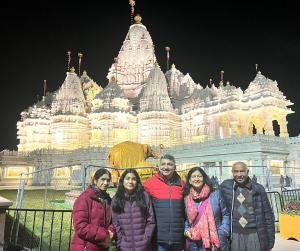
It was blissful and a blessing to visit the majestic, magnificent, and mesmerizing architectural marvel, the Akshardham Temple in New Jersey. The second-largest in the world and the largest of the three Akshardham temples is the New Jersey temple (mandir). The other two are in New Delhi and Gandhinagar, India. The Akshardham under discussion stands about 191 feet at its highest point, on more than 180 acres of land with nearly 10,000 statues.
Interesting to note that the largest Hindu temple is not in Hindu-dominated Bharat (that is India). Rather, the largest temple dedicated to Lord Vishnu is Srirangam Ranganathaswamy Temple in Cambodia. The Angkor Wat temple complex in Cambodia is located on about 402 acres of land.
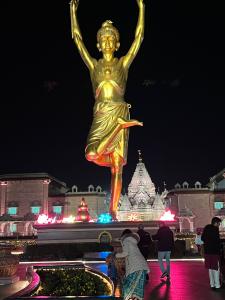
Bhagwan Swaminarayan
A towering 49-foot statue of teenager Bhagwan Swaminarayan (Neelkanth Varni) in a yoga pose stands on the grounds next to the Brahmakund (a reservoir of holy water from hundreds of different rivers and lakes from around the world). Examples include water from Ganga and Yamuna in India, and the Mississippi, East River, and Lake Michigan in the United States. A 3-D map shows the 7500-mile journey undertaken by young Swaminarayan.
Swaminarayan ji is God’s visionary messenger and the founder of a religious sect, the BAPS (Bochasanwasi Akshar Purushottam Swaminarayan Sanstha ). The Akshardham in New Jersey is an imposing place of worship and a lightning rod for spreading the core principles of Hinduism.
The BAPS is a unique religious and spiritual institution that’s prominently adding to the Hinduism renaissance globally. The BAPS temples are open to all who seek blessings and/or want to learn Swaminarayan’s message through his followers for more than a century.
The New Jersey Akshardham is a beacon of universal beliefs of love for humanity, service to humankind, and spirituality. We had the privilege of visiting the temple on November 13, the day after Deepavali (or Diwali), a globally celebrated festival of lights. This is the day when ignorance, darkness, and evil disappear and knowledge, brightness, and good, respectively make a home for Hindus.
The following is a humble attempt to introduce the grandiose Akshardham based on personal observations and a bit of literature search (1, 2, 3) and the BAPS website. The BAPS is credited for expansive and extraordinary efforts toward the renaissance of Hinduism through more than 100 Hindu temples and centers worldwide. The author lacks the competence to write all about it nor the repetition is justified. There is already an extensive repository of all the facts and figures about the BAPS.
Akshardham in New Jersey
The Akshardham is an expansive version of BAPS temples around the world. These include the life history of BAPS’s founding father, his successors and followers, and an exhibition to celebrate the ancient Hindu religion, its traditions, and its rich heritage and culture.
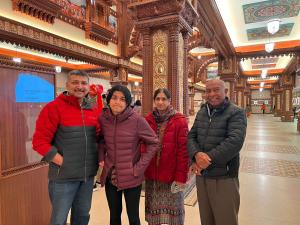
During our visit, we were greeted in the intricately decorated welcome center. A volunteer guide, Krishna, an articulate, humble, and believer in Bhagwan Swaminarayan was assigned to us. This was arranged through the Minnesota-based BAPS temple which we visited for the festival of Annakut (the mountain of food) in 2022. We will discuss Annakut in another article.
The Akshardham complex in New Jersey has two parts. The preexisting BAPS Mandir for the daily religious rituals and the recently added ‘Maha Mandir (grand temple)’ completed over 12 years (2011-2023). It was opened to the public in October and is still considerable finishing touch-up work is underway.
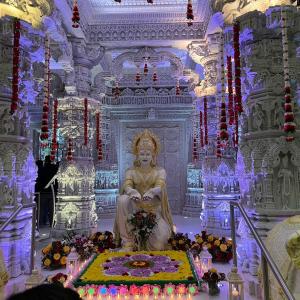
Walking to the Mandir, youth volunteers greeted us with folded hands wishing us Happy New Year. In the Hindu calendar, the new year begins the day after Deepavali. We were at the temple when the festival of Annakut was underway.
Mandir to Maha Mandir

As we walked beyond the preexisting temple to the newly completed Akshardham, the construction history was evident. For example, the written description of four different types of stones- limestone, sandstone, marble, and granite. The mandir used these stones appropriately to withstand extreme temperature swings. The volunteer tour guide told us that three primary sources for the stones were India, Italy, and Turkey. The visitors experienced how chisel and hammer were used for the intricate carvings and how the carved pieces were assembled.
Along the way, the walls had Bhagwan Swaminarayan’s messages about human virtues and life values. These include Tranquility, Faith, Spirituality, Harmony, Heritage, Beauty, Strength, Serenity, Celebration, and Knowledge.

Service (Seva) by Volunteers
Lakshmi talked about the extraordinary commitment of volunteers for Seva during the construction of the temple. The men, women, and young adults came from everywhere and performed age/skill-appropriate tasks. Reportedly, an army of volunteers (12,500) dedicated ten days to as many as five years of seva to build this Akshardham. It is an awesome spirit of service. In the future, the Akshardham will house a museum and interactive exhibits explaining the history and core values of Hinduism.
Lakshmi told the mandir perimeter has quotes from Hindu scriptures, thought leaders, and eminent personalities. These include Einstein, Socrates, Martin Luther King, Abraham Lincoln, Buddha, Mirabai, and more. It is a reflection that Akshardham is a center for universal teachings and a vision for attracting visitors of diverse faiths.
The Maha Mandir
In his blessings after the sacred ritual of Akshardham’s opening, Mahant Swami Maharaj, the current BAPS head and the sixth successor of Swaminarayan Bhagwan, said, “May all souls who come here experience param shanti (eternal bliss) and param anand (eternal happiness) in their lives. Governor Carney remarked, “The temple is a bridge, a bridge from the past to the future, a bridge from India to America, a bridge from one community to the next.”
Akshardham stands to honor Bhagwan Swaminarayan’s vision along with Hindu Deities across its 13 inner sanctums. The intricate carvings include the poses of the Bharatnatyam dance. The numerous carved elephants look similar but are different in minute detail. Two of the columns have depictions of the Hindu scriptures Ramayana and Mahabharat. The “wow” is best summed up as, “ Every inch of the surface area is covered by astrological symbols, narrative reliefs, elephants, botanical motifs — a visual catalog of Hinduism, conceived by someone who abhors blankness.”
Concluding Thoughts
The Swaminarayan temples attract not only the commoners but also the dignitaries. Recently, British Prime Minister Sunak (and his wife) visited Akshardham in New Delhi in September (during G 20). Likewise, Bharat’s External Affairs Minister Jaishankar (and his wife) visited the BAPS temple in London during Deepavali days. He later tweeted, “Blessed to visit the BAPS Shri Swaminarayan Mandir, London on Deepavali. Prayed for the peace, harmony, and prosperity of our community around the world.”
We had so little time to see, digest, and appreciate so much of the legendary Maha Mandir. One needs a minimum of 6-8 hours to see, believe, and appreciate its splendor. Photos alone would do little justice to the intricate stonework and beauty of this historical monument.
Today, Bhagwan Swaminarayan’s vision is taking shape through Akshardham-like institutions. BAPS’s mandirs will strengthen and promote the basic tenets and teachings of Hinduism for centuries to come.
We close with Jai Swaminarayan Bhagwan, Jai Shri Krishna, and Jai Shri Ram.
NOTE: This article is not generated using Chat GPT or any form of Artificial Intelligence.





